Like many places in Taiwan, Shanhua (善化) has had more than one name in its history. The first recorded was Bakaloan, a toponym used by the local Siraya indigenous people, and written 目加溜灣 by Holo-speaking Han settlers.
The Dutch East India Company in 1635 seized this corner of what’s now Tainan and endeavored to Christianize the inhabitants. After the Dutch were thrown out, the Kingdom of Dongning — the statelet established by Zheng Chenggong (鄭成功, also known as Koxinga ) and his band of Ming-dynasty loyalists — decreed that the settlement would be known as Shanhua. However, when Taiwan became part of the Qing Empire, the place name was changed to Wanlishe (灣裡社).
PROMOTING LITERACY
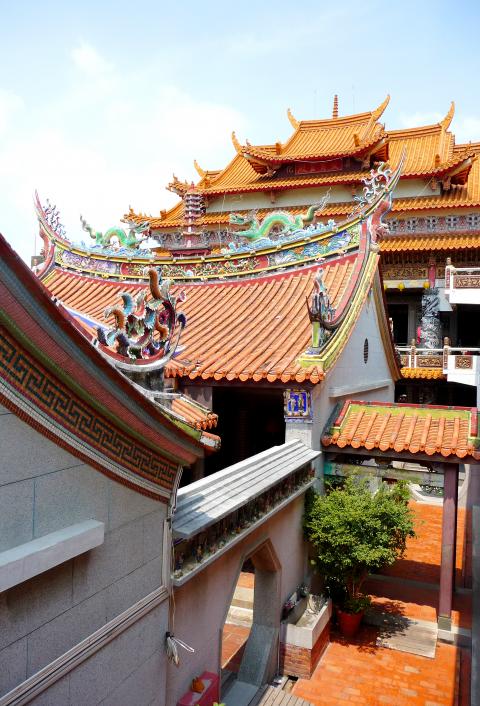
photo by Steven Crook
One man who lived here for a major part of the Dongning era is now revered as a pioneer of classical Chinese education in Taiwan. Shen Kuang-wen (沈光文) was born in China’s Zhejiang Province in 1612, but after the collapse of the Ming dynasty in 1644 he was forced to flee southward. After living for a while in poverty, he sailed to Taiwan a few months after Zheng Chenggong’s death. Hagiographies that have him arriving in Taiwan as early as 1649 have been shown to be wrong.
Shen’s efforts to promote literacy and Han civilization have earned him a place on the altar inside Shanhua’s most historic place of worship, Qingan Temple (慶安宮). The temple stands on the town’s busiest thoroughfare, right where — so it’s said — a Protestant church existed during the Dutch period. This site hosted a Confucius Temple at the beginning of the 18th century, then a shrine dedicated to Wenchang Dijun (文昌帝君), a god of culture and literature and the patron deity of those about to sit academic examinations.
That structure was wrecked in an earthquake in 1861, and the name Qingan Temple first appeared four years later when its replacement was completed. The principal deity nowadays is Mazu (媽祖). In the hall behind her, Guan Yu (關羽) occupies the central position.
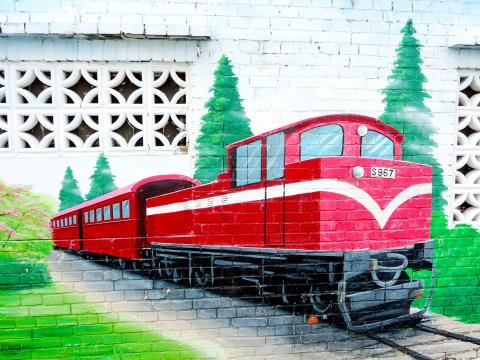
photo by Steven Crook
In front of Guan Yu, there are five soot-covered non-identical effigies of Wenchang Dijun. On the left, and slightly closer to those offering incense, another and somewhat less begrimed statuette represents Shen.
There are a couple of other reminders of the scholar elsewhere in the town. Shanhua Junior High School has a Kuang-wen Building (光文樓). Just north of Shanhua Taiwan Railway Administration Station, and clearly visible from trains, the Shen Kuang-wen Memorial (沈光文紀念碑) was dedicated in 1978. It’s believed Shen, who died in 1688, was buried hereabouts.
SUGAR INDUSTRY
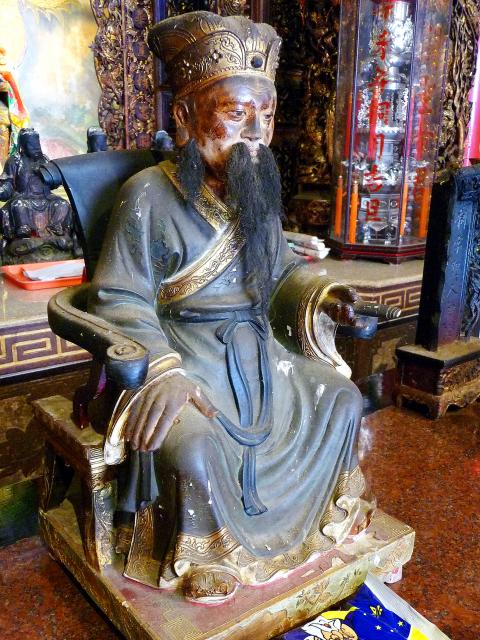
photo by Steven Crook
Even before Shen’s arrival in Shanhua, sugar had emerged as an important part of the local economy. The Dutch incentivized farmers to grow sugarcane because the commodity fetched a good price in Japan.
Sugar remained a key cash crop after the Europeans left, but physical remnants of the industry that existed before the Japanese colonial period are few and far between. Earlier this year, however, Tainan City Government’s Cultural Affairs Bureau announced an important discovery in Shanhua. During excavations ahead of a house construction, a set of six “stoves” used to produce sugar more than 150 years ago was found. Whether they will be preserved in situ or moved elsewhere has yet to be decided.
In 1946, when the incoming Chinese Nationalist Party (KMT) government created Taiwan Sugar Corp (TSC) to take control of the island’s sugar industry, Taiwan had 42 sugar factories and refineries. Several of them had sustained damage during World War II; the US Air Force targeted sugar-industry sites because they supplied ethanol to the Japanese military. Before the war, Taiwan was the world’s no. 4 source of sugar, and cane plantations covered a fifth of the island’s farmland. In the early 1950s, sugar exports accounted for 73.6 percent of the country’s foreign-currency earnings.
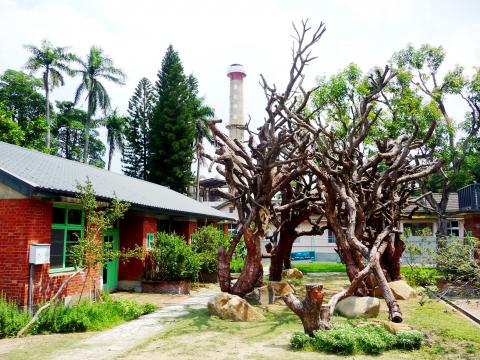
photo by Steven Crook
TSC even had its own railway network. A few remnants of the narrow-gauge branch lines that use to criss-cross the industry’s heartlands can be found beside the roads that approach Shanhua Sugar Factory (善化糖廠), one of the last two sugar factories still operating in Taiwan. (The other is in Huwei (虎尾) in Yunlin County; TSC’s sugar refinery in Siaogang (小港), not far from Kaohsiung International Airport, also continues to function.)
If you arrive on one of the approximately 110 days per year that the sweet stuff is being produced, you’ll notice a pleasant odor as soon as you enter that part of the complex that’s open to the public. The unmarried-employees quarters look a little tatty, but the redbrick former dormitory next door is pristine and appealing. A renovation/repurposing project to convert it into a restaurant with indoor and outdoor-seating is almost complete. A steam locomotive imported from Belgium in 1948 is preserved here.
Another small building houses Shanhua Sugar Museum (善糖文物館, open 9:30 am to 4pm daily; free admission). There’s very little English inside, yet fans of industrial heritage are sure to enjoy the mechanical calculators, the early 1970s Chinese-script typewriter and the soil-analysis equipment.
Several black-and-white photos deserve careful examination. One shows a TSC train on a stretch of track with three rails, the outer two being 1,067mm apart for the use of Taiwan Railways Administration rolling stock, the inner rail marking the 762mm gauge that was TSC standard.
About 2.5km from the sugar factory, and a few hundred meters west of the high-speed railway, Hucuoliao Painted Village (胡厝寮彩繪村) attracts a trickle of photographers.
Unlike Taichung’s famous Rainbow Village (彩虹眷村), Hucuoliao isn’t a former military dependents’ village, but rather an ordinary rural community. Many of the paintings depict cartoon characters or fairy tales like Little Red Riding Hood, but there are also some well-executed emblems of Taiwan. Thanks to the black-faced spoonbills and the Alishan logging train, even the most humorless patriot will find a satisfactory backdrop for selfies.
Steven Crook has been writing about travel, culture, and business in Taiwan since 1996. Having recently co-authored A Culinary History of Taipei: Beyond Pork and Ponlai, he is now updating Taiwan: The Bradt Travel Guide.

Water management is one of the most powerful forces shaping modern Taiwan’s landscapes and politics. Many of Taiwan’s township and county boundaries are defined by watersheds. The current course of the mighty Jhuoshuei River (濁水溪) was largely established by Japanese embankment building during the 1918-1923 period. Taoyuan is dotted with ponds constructed by settlers from China during the Qing period. Countless local civic actions have been driven by opposition to water projects. Last week something like 2,600mm of rain fell on southern Taiwan in seven days, peaking at over 2,800mm in Duona (多納) in Kaohsiung’s Maolin District (茂林), according to

Aug. 11 to Aug. 17 Those who never heard of architect Hsiu Tse-lan (修澤蘭) must have seen her work — on the reverse of the NT$100 bill is the Yangmingshan Zhongshan Hall (陽明山中山樓). Then-president Chiang Kai-shek (蔣介石) reportedly hand-picked her for the job and gave her just 13 months to complete it in time for the centennial of Republic of China founder Sun Yat-sen’s birth on Nov. 12, 1966. Another landmark project is Garden City (花園新城) in New Taipei City’s Sindian District (新店) — Taiwan’s first mountainside planned community, which Hsiu initiated in 1968. She was involved in every stage, from selecting
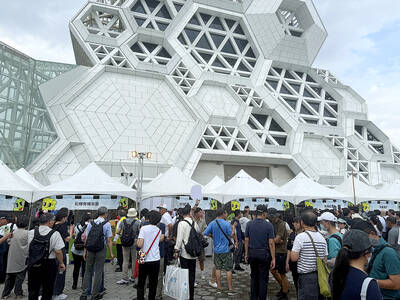
The latest edition of the Japan-Taiwan Fruit Festival took place in Kaohsiung on July 26 and 27. During the weekend, the dockside in front of the iconic Music Center was full of food stalls, and a stage welcomed performers. After the French-themed festival earlier in the summer, this is another example of Kaohsiung’s efforts to make the city more international. The event was originally initiated by the Japan-Taiwan Exchange Association in 2022. The goal was “to commemorate [the association’s] 50th anniversary and further strengthen the longstanding friendship between Japan and Taiwan,” says Kaohsiung Director-General of International Affairs Chang Yen-ching (張硯卿). “The first two editions
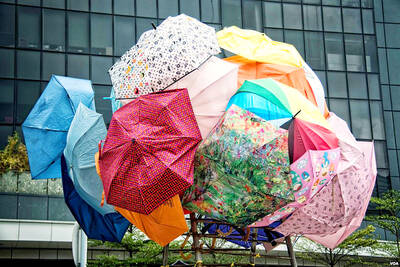
It was Christmas Eve 2024 and 19-year-old Chloe Cheung was lying in bed at home in Leeds when she found out the Chinese authorities had put a bounty on her head. As she scrolled through Instagram looking at festive songs, a stream of messages from old school friends started coming into her phone. Look at the news, they told her. Media outlets across east Asia were reporting that Cheung, who had just finished her A-levels, had been declared a threat to national security by officials in Hong Kong. There was an offer of HK$1m (NT$3.81 million) to anyone who could assist